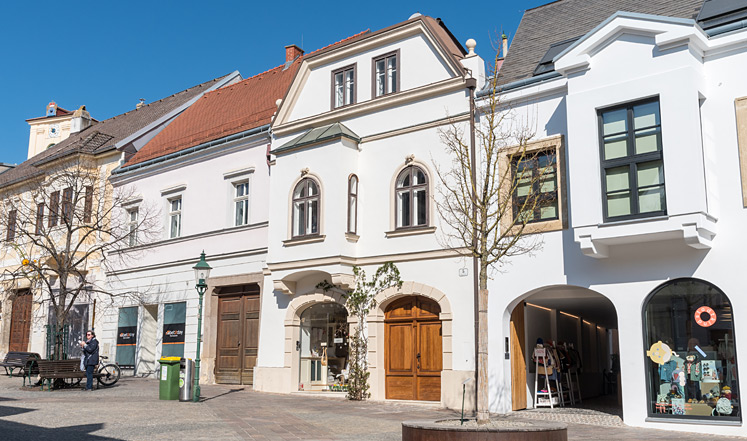
Eisenstadt – Small But Great!
By Reinhard Mandl*
Esterházy Castle can be seen from afar on the route from Wulkaprodersdorf to Eisenstadt: It sits slightly elevated on the foothills of the Leitha Mountains overlooking Eisenstadt, the capital of Burgenland. It is amusing that the capital of the flattest state in Austria lies at the foot of a mountain! Eisenstadt describes itself as the “smallest big city in the world” and, in terms of its low population, the town has a lot to offer, especially culturally: The Kalvarienberg and the Jewish cemetery are at the top of my list of places to visit.
The "smallest big city in the world"
The regional express to Deutschkreutz is painted in bright green and yellow and the logo of the GySEV/Raaberbahn is emblazoned next to the doors. The abbreviation GySEV is Hungarian and stands for Györ-Sopron-Ebenfurti-Vasút, in other words: Raab-Oedenburg-Ebenfurth Railway, abbreviated to ROeEE in German.
We pass through the scenic Viennese Basin and soon reach Ebenfurth on the banks of the Leitha. From here on, the train continues on the Raaberbahn network. Today, Ebenfurth is located on the border between Lower Austria and Burgenland, but the state border with Hungary ran here until 100 years ago. At the time of its commissioning in 1879, the Raaberbahn was almost entirely on Hungarian territory. Ebenfurth, the terminus of this railway line, was the first station on the Austrian side until 1921.
I could actually get off in Müllendorf and hike directly to Eisenstadt. The village on the southern slope of the Leitha Mountains is located in a charming area. It is faster by train, of course, but the journey does take a detour since the Raaberbahn line leads past Eisenstadt. In Wulkaprodersdorf, I leave the REX 6 and change for the REX 64. Now I am on the Pannonia railway, which passes near Lake Neusiedl and goes up to Parndorf and the Eastern Railway. My journey ends after only seven kilometres, in Eisenstadt. The station is outside the city centre and gives no impression of its eventful history. In 1956, following the suppression of the Hungarian uprising, more than 100,000 refugees passed through here. Eisenstadt was then the starting point for direct rail transport to England, Belgium and other countries.
There are small city buses waiting directly at the train station, which do not have numbers, but names. I take the “Vitus” to Esterházy Castle, the city’s main landmark. When Ladislaus Esterházy was appointed as ruler of the city in 1648, Eisenstadt was elevated to the status of a free city. The bourgeois counterpart to the castle, the magnificent town hall, whose façade is adorned with a striking ribbon of frescoes, also dates from this period. It stands on the Hauptstrasse (Main Street), which now functions as a pedestrian zone. Though it is still morning, the beer gardens and outdoor dining areas on this popular promenade are already filling up. I plan out my sightseeing over some coffee and cake. The main attractions are close enough to explore on foot along the Haydn Trail.
I first head to the former Jewish quarter, where the State Museum of Burgenland is located. This universal museum houses thousands of artefacts from over 10,000 years of human history in a region that has just recently celebrated its 100th anniversary as a part of Austria. The block where it is housed belonged to Jewish owners until 1939.
Passing the Austrian Jewish Museum on Unterbergstrasse, I walk up to the Kalvarienberg, a cavalry mountain which at first glance looks like a church with a conspicuously curved roof. But this impression is deceptive because the church hides behind this artificial stone-built mountain with its covered stairs and passages. These lead past small chapels and grottos, where the story of the suffering of Jesus is depicted. The “Mountain Church” (Bergkirche) was later constructed on the back of the Kalvarienberg and is also known by that name. It has a third name as well: Haydn Church. After all, the remains of the famous composer Joseph Haydn, who was the kapellmeister (choir master) of the Esterházy family for almost 30 years, are preserved here. He was mainly active in the nearby castle.
At midday, my path leads up to the Gloriette, but before I take a seat in the restaurant’s garden, I take a short walk among the fir trees of the Föhrenwald to the Jubiläumswarte observation deck on the Parapluie meadow. I already saw the wooden tower through the train window. The view from the top stretches all the way to Lake Neusiedl.
The Gloriette Avenue leads me back to the city. I get a key from the concierge at the hospital that lets me access the older of the two Jewish cemeteries. I am looking for the tombstone of Hirz Kamen, who died on the 23rd Tammuz 5439. In our era, this was the 3rd of July, 1679, as I read on the information plaque that identifies this tombstone as the oldest in the cemetery. Each of the more than 1000 tombstones is labelled with small location markers and is therefore easy to identify.
The time comes for me to slowly start thinking about the return journey, but before I do so, I still want to see the house of Joseph Haydn. It is located in the alley named after him, alongside other houses with baroque façades. Unfortunately, far too many cars disturb the atmosphere of this narrow alley and make it difficult to go back to the time when the princely kapellmeister walked the streets.
I take the city bus “Fanny” back to the train station, from where trains go directly to Vienna Central Station every hour. The journey up to Parndorf is on the Pannonia railway line again, which runs between the Leitha Mountains and Lake Neusiedl, past the well-known wine-growing villages of Donnerskirchen, Purbach, Breitenbrunn and Jois. Looking out of the windows to my right, I see an extensive belt of reeds, behind which the steppe lake can only be glimpsed. Unfortunately, the lake is drying out more and more. The tracks run at a reasonable distance to the B 50 trunk road, and I feel as if I am floating through the exotic Pannonian landscape. In a few weeks the cherries will be in bloom here – maybe I will come back then. It is always the same: As soon as an excursion is coming to an end, the next destination already becomes imminent!
My timetable on the 21/03/2022:
depart from Vienna Central Station at 9:23 am, arrive in Eisenstadt at 10:26 am // depart from Eisenstadt at 5:27 pm, arrive at Vienna Central Station at 6:43 pm (via Parndorf)
* This text is an abridged version of chapter 6 of his book Discover Austria with the KlimaTicket – 20 Trips by Bus and Rail.













